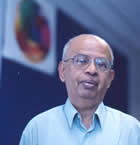|
Academic Staff - Dr T. Thirunamachandran - Theoretical Chemistry
Dr. Thiru deceased on 13. October 2008 Molecular quantum electrodynamics deals with both radiation-molecule and molecule-molecule inter-actions. Current research interests centre around the applications of quantum electrodynamics to optical activity, intermolecular forces, energy transfer and multiphoton processes. Our interests also include the development of simple methods within the framework of quantum electrodynamics that are suitable for applications in chemical physics. Intermolecular ForcesFrom the point of view of quantum electrodynamics, intermolecular interactions arise from an exchange of virtual photons. A theory based on such an exchange leads to a direct understanding of retardation effects. A well-known example is the Casimir potential, showing an inverse seventh power dependence on distance for large intermolecular separations instead of an inverse sixth power predicted by elementary quantum mechanics. The theory is being extended to interactions involving molecules in excited states and to many-body interactions. An interesting extension of the theory is the calculation of discriminatory interaction energies between optically active molecules, i.e. energies dependent on the relative handedness of the molecules. Modifications to intermolecular interactions in the presence of an incident radiation field are also being investigated. A study of excitation transfer between molecules in a medium is in progress. Multiphoton ProcessesWith the advent of lasers, particularly tunable lasers, there has been considerable activity, both experimental and theoretical, in a variety of multiphoton processes. Such processes provide valuable information about molecular properties such as hyperpolarizabilities. They also provide a means of determining the symmetry properties of energy levels not accessible by one-photon transitions. Current studies include circularly polarized luminescence and laser-induced optical activity. Applications of the Heisenberg FormalismIn studies of time-dependent phenomena in chemical physics, the Schrödinger formulation of quantum mechanics is widely employed. However, in many cases the Heisenberg formulation provides additional valuable insight. The method has been applied to a wide range of phenomena, including energy transport and induced circular dichroism. A form of response theory based on the response of a molecule to the electromagnetic fields of other molecules is being developed. The theory will then be applied to many-body forces. Selected Publications
This page last modified 9 August, 2010 |
|

